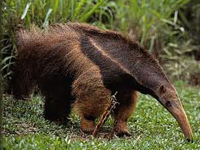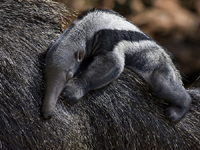

 |

|
 Giant Anteater |
Giant Anteater(Mammal) |
 Giant Anteater Baby |
Giant Anteater HabitsThe giant anteater lives a solitary life. It is rarely seend with another anteater. When two animals are together it is either for the purpose of mating or it is a mother with her young. Its habitat includes the rainforests, grasslands, and mixed forest and semiarid regions of Central and South America.
The giant anteater and the other three species of anteater live only in Central and South America. The giant anteater is the most vulnerable species of anteater and is likely to become in danger of extinction in the next few years, unless measures are taken now. |
Giant Anteater CommunicationGiant Anteaters do not have a good sense of sight or hearing but their sense of smell is excellent. They are generally silent and most communication occurs between a mother and her young. They communicate by snorts, hisses, sniffs and if they are alarmed or fighting sometimes they roar. |
Giant Anteater BreedingLittle is known about the courtship and mating habits of giant anteaters. It is believed that males and females come together only to mate. The mother carries the young inside her for 190 days. The mother gives birth while standing and will use her long tail like a third leg for support.
At birth, the baby immediately scrambles onto its mother's back. It has a complete coat of fur that is so similar in color to its mother's that the youngster is often difficult to recognize when it is with its mother. The mother suckles her young for about six months. During this time, the baby will cling to its mother's back, although it is able to walk a month after birth.The offspring is slow to mature; it does not become independent until the mother is pregnant again and will not feed on its own until it is two years old. |
Giant Anteater Food & FeedingThe giant anteater's diet consists mainly of ground-dwelling andts, although it will occasionally eat termites and army ants. The anteater's acute sense of smell detects the ants. Its long claws are used to get into the nests. It catches the ants with its long, sticky tongue. It gets most of the moisture it needs from its food, which includes fruit and larvae. |
Giant Anteater Key Facts |
| Size |
| Height: Length:40-48 in. Tail 28-35 in |
| Weight: 44-90 lb. Males slightly heavier than females |
| Breeding |
| Sexual maturity: 2-3 years |
| Mating: March to May |
| Gestation: 190 days |
| Number of young: Usually 1 |
| Lifestyle |
| Habit: Solitary; nocturnal near towns, but a daytime feeder in remote areas |
| Diet: Ground-dwelling ants |
| Lifespan: 26 years in captivity |
DID YOU KNOW?
|
CAN'T FIND WHAT YOU'RE LOOKING FOR? CLICK HERE!!!